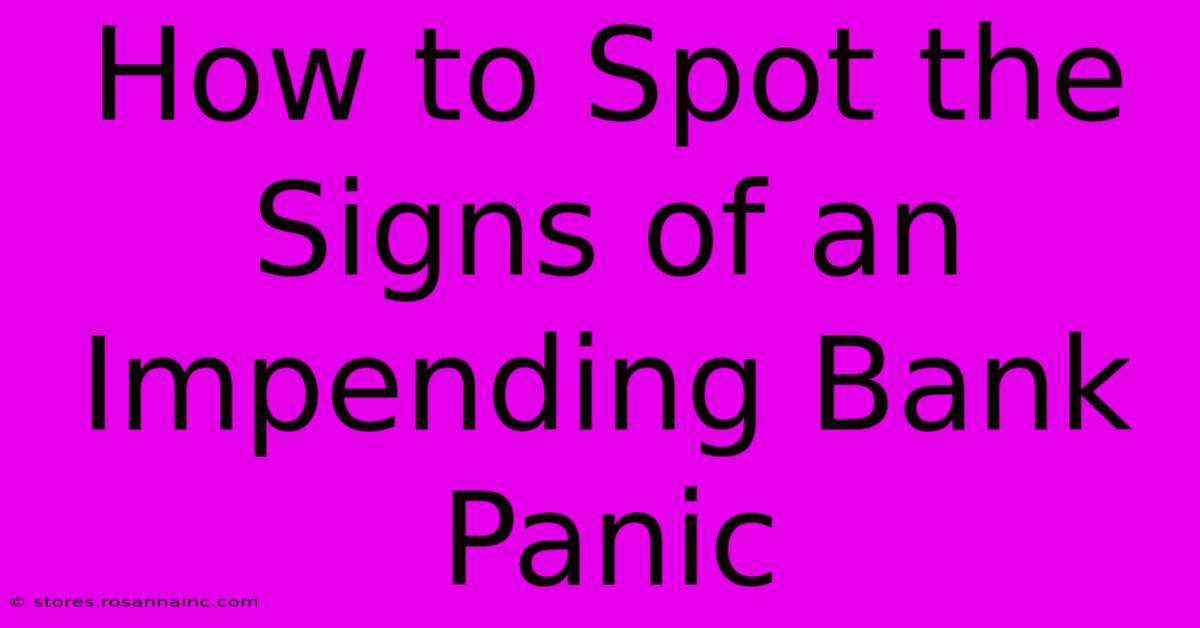How To Spot The Signs Of An Impending Bank Panic

Table of Contents
How to Spot the Signs of an Impending Bank Panic
Bank panics, while rare in well-regulated economies, can have devastating consequences. Understanding the warning signs can help individuals, businesses, and investors protect themselves. This article will explore key indicators that suggest a potential banking crisis is brewing.
Understanding the Fundamentals: What Causes Bank Panics?
Before diving into the signs, it's crucial to understand the underlying causes. Bank panics are essentially a loss of confidence in the banking system. This loss of confidence can stem from several factors, including:
- Economic downturns: Recessions and financial crises often trigger bank runs as businesses and individuals face financial difficulties.
- Regulatory failures: Inadequate oversight and weak regulations can create vulnerabilities within the banking system, leading to instability.
- Asset bubbles: The bursting of asset bubbles (like housing or technology stocks) can severely impact bank balance sheets and trigger panic.
- Cyberattacks and fraud: Large-scale cyberattacks targeting financial institutions can erode public trust and lead to bank runs.
- Geopolitical instability: Major geopolitical events can create uncertainty and fear, prompting depositors to withdraw their funds.
Key Indicators of an Impending Bank Panic:
Identifying the early warning signs requires careful observation and analysis. Here are some key indicators:
1. Increased Bank Failures or Near-Failures:
A significant increase in the number of banks failing or requiring government bailouts is a major red flag. This indicates systemic weaknesses within the banking sector. Pay close attention to news reports and financial statements.
2. Rising Interbank Lending Rates:
Banks borrow money from each other regularly. A sharp increase in the rates at which they lend to each other suggests a lack of trust and increased risk perception within the banking system itself. This is a crucial early warning sign often missed by the average person.
3. Decreased Liquidity in the Banking System:
Liquidity refers to the ease with which banks can convert assets into cash. A decline in liquidity indicates that banks are struggling to meet their immediate obligations. News reports about banks struggling to meet withdrawals could be an indicator.
4. Increased Volatility in Financial Markets:
Sharp fluctuations in stock prices, especially in the financial sector, often signal growing uncertainty and anxiety about the health of the banking system. Monitor market indices and pay attention to significant daily price swings.
5. Run on Deposits at Individual Banks:
While less common in the modern era due to deposit insurance schemes, a sudden and significant outflow of deposits from a specific bank can be a sign of a larger problem. News of deposit runs at particular institutions should raise concern.
6. Deteriorating Credit Ratings of Banks:
Credit rating agencies constantly assess the financial health of banks. Downgrades in credit ratings indicate increased risk and potential insolvency, which can trigger a loss of confidence. Follow the credit ratings of major banks.
7. Changes in Government Policy or Regulation:**
Sudden and significant changes in government policies or regulations related to the banking sector often reflect attempts to address underlying problems, highlighting potential systemic vulnerabilities. Pay attention to government announcements and regulatory actions.
8. Negative Media Coverage and Public Sentiment:**
Negative media coverage focusing on the financial instability of banks can fuel panic and accelerate a crisis. Be aware of the narrative surrounding banking news.
What You Can Do: Protecting Yourself During a Potential Bank Panic
While preventing a bank panic is largely the responsibility of regulators and policymakers, individuals and businesses can take steps to mitigate their risks:
- Diversify your assets: Don't keep all your money in one bank or institution.
- Monitor your bank's financial health: Stay informed about your bank's performance.
- Maintain an emergency fund: Have sufficient cash reserves to cover your immediate needs.
- Understand deposit insurance limits: Know the extent of your protection under deposit insurance schemes.
- Consider alternative investment options: Explore investment options less vulnerable to bank panics.
Conclusion: Vigilance is Key
Spotting the signs of an impending bank panic requires vigilance and a clear understanding of the financial landscape. By monitoring key indicators and taking proactive measures, individuals and businesses can better protect themselves from the potentially devastating consequences of a banking crisis. Remember, early detection and preparedness are crucial.

Thank you for visiting our website wich cover about How To Spot The Signs Of An Impending Bank Panic. We hope the information provided has been useful to you. Feel free to contact us if you have any questions or need further assistance. See you next time and dont miss to bookmark.
Featured Posts
-
From Curb Kiss To Car Repair Navigating The Aftermath
Feb 11, 2025
-
Miller Lite Alcohol Content Everything You Need To Know
Feb 11, 2025
-
Beyond The Green The Unexpected Health Benefits Of Golf
Feb 11, 2025
-
Timothy B Schmit Untold Eagles Stories You Wont Believe
Feb 11, 2025
-
Central Parks Troll Myth Magic And Must See Photo Ops
Feb 11, 2025
